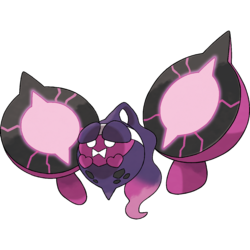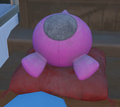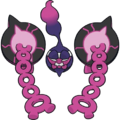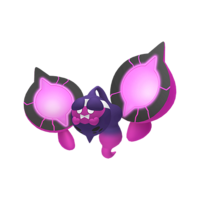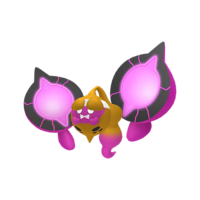Pecharunt (Japanese: モモワロウ Momowarou) is a dual-type Poison/Ghost Mythical Pokémon introduced during Generation IX, in The Indigo Disk (though it was not made available until the release of Mochi Mayhem).
It is not known to evolve into or from any other Pokémon.
It is the leader of the Loyal Three, and is associated with Ogerpon.
Biology

Pecharunt inside its shell
Pecharunt is a small Pokémon resembling a piece of mochi. It has two forms it can take both inside and outside of battle. The first form resembles an upside-down peach, with a black circular face at the center and a thin, vertical line splitting its body into two halves. In its face are two white semicircle eyes, appearing to be frowning. It takes its second form upon opening up, revealing a smaller inner body resembling a peach's pit. It has a darker purple and pink body with two white eyes which are usually frowning, below which is a white, ribbon-shaped mouth. On its head rests two purple flaps and a scorpion-like ponytail. It has two heart-shaped paws at the bottom of its body, along with three black dots on each side underneath them. The discarded shell floats on both sides of Pecharunt, forming spiky wing-like appendages. The inside of these shells have a bright pink glow, outlined in black. The bright pink extends slightly through the black outline in six thin lines. The chains have a magenta color to them and are divided in identical segments, ending in a slightly larger segment with two protrusions, making it resemble the shape of Pecharunt's shell.
According to the player, Pecharunt smells incredibly sweet.[1] It is known to feign weakness by weeping, and acting like a baby in order to gain sympathy from others.[2] If mortally wounded, Pecharunt will retreat into its shell and remain asleep for years so it can regain its strength. After being knocked out in Kitakami, it started being known as the "Never-Rotting Peach" due to its peach-like shell.

Carmine under the effects of the Binding Mochi
Pecharunt stores poison in its peach-shaped shell and uses it to create toxic chains and roll up poisonous Binding Mochi, which are stored in its shell until they are needed. It is able to use its toxic chains in combat, badly poisoning its enemies in the process. The chains are also capable of empowering other Pokémon, using its toxins to enhance certain aspects of their bodies, such as their muscles, brain, or looks, as seen with Okidogi, Munkidori, and Fezandipiti, respectively. It serves its mochi to Pokémon and humans, but may also shoot them at their mouths if necessary. According to Penny, the mochi that Pecharunt creates are somewhat sweet. The mochi draw out their deepest desires and powers, but the ones who eat it become chained to Pecharunt's will, as seen with its caretakers, who had their greed drawn out. In some cases, the ones that eat it may completely fall under its control, as seen with Mossui Town's residents and the player's friends from Paldea.
Humans under Pecharunt's control have purple eyes and are surrounded by a purple aura. The controlled humans also hold their arms while performing a chicken dance-like movement, repeating the word "mochi" constantly. However, in some cases, like with Hideko, it is shown that the possessed human can still speak somewhat freely, though it may simply be Pecharunt influencing the propagation of the mochi among humans. Humans under its influence are often still prone to innate emotion and desires — Arven is visibly embarrassed while dancing, Penny instinctively combines the word "mochi" with "Veevee", and Nemona still expresses a strong urge to battle, being able to morph "mochi" into "match". It can even command humans, and Pokémon to fight for it in battles, capable of controlling multiple creatures at once. It relies on others to fight for it due to its cowardly personality and size. However, Pecharunt will fight back if it is has no other option. Capturing Pecharunt will free those under its control with no memories of being controlled. The effect of Pecharunt's mochi on people are likened by Kieran to a curse.
According to myth, Pecharunt came from a distant land where it was adopted by an elderly couple with no children. Pecharunt fed its adoptive parents Binding Mochi to secure their affection, which brought out their inner greed. They made many requests of Pecharunt, who gave them what they requested to be showered with further attention. The couple eventually asked for a brilliant set of masks, which could only be found in Kitakami. Pecharunt left to obtain the masks, recruiting Okidogi, Munkidori, and Fezandipiti to aid in its quest. They successfully stole three masks from Ogerpon, who defeated and slayed the Loyal Three in retaliation; Pecharunt only survived by going dormant within its shell. It would not surface found again until hundreds of years later when a Mythical Pecha Berry awoke it.

|
Spoilers end here.
|

|
Pecharunt is the only known Pokémon capable of learning the move Malignant Chain. It is also the only known Pokémon that can have Poison Puppeteer as an Ability.
Pecharunt mimicking a decoration as it slumbers in Peachy's
Pecharunt firing its Binding Mochi from its shell halves
Game data
NPC appearances
- Main article: Pecharunt (game)
Pokédex entries
| This Pokémon was unavailable prior to Generation IX.
|
| Generation IX
|
|
Paldea
#—
|
|
Kitakami
#—
|
|
Blueberry
#243
|
| Scarlet
|
It feeds others toxic mochi that draw out desires and capabilities. Those who eat the mochi fall under Pecharunt’s control, chained to its will.
|
| Violet
|
Its peach-shaped shell serves as storage for a potent poison. It makes poisonous mochi and serves them to people and Pokémon.
|
|
|
Game locations
| This Pokémon was unavailable prior to Generation IX.
|
|
|
Stats
Base stats
| Stat
|
Range
|
| At Lv. 50
|
At Lv. 100
|
88
|
|
148 - 195
|
286 - 380
|
88
|
|
83 - 154
|
162 - 302
|
160
|
|
148 - 233
|
292 - 460
|
88
|
|
83 - 154
|
162 - 302
|
88
|
|
83 - 154
|
162 - 302
|
88
|
|
83 - 154
|
162 - 302
|
Total: 600
|
Other Pokémon with this total
|
- Minimum stats are calculated with 0 EVs, IVs of 0, and (if applicable) a hindering nature.
- Maximum stats are calculated with 252 EVs, IVs of 31, and (if applicable) a helpful nature.
|
Type effectiveness
| Under normal battle conditions in Generation IX, this Pokémon is:
|
|
|
|
|
|
|
|
|
|
|
|
|
Learnset
Pecharunt was introduced in Scarlet and Violet Version 3.0.0.
|
|
|
|
- Bold indicates a move that gets STAB when used by Pecharunt
- Italic indicates a move that gets STAB only when used by an Evolution of Pecharunt
|
|
|
|
|
- Bold indicates a move that gets STAB when used by Pecharunt
- Italic indicates a move that gets STAB only when used by an Evolution or an alternate form of Pecharunt
|
|
|
|
|
- Moves marked with an asterisk (*) must be chain bred onto Pecharunt
- Bold indicates a move that gets STAB when used by Pecharunt
- Italic indicates a move that gets STAB only when used by an Evolution of Pecharunt
|
Side game data
Pokémon GO
| File:GO1025.png
|
Base HP: 204
|
Base Attack: 181
|
Base Defense: 273
|
| Egg Distance: N/A km
|
Buddy Distance: 20 km
|
Evolution Requirement: N/A
|
| Fast Attacks:
|
| Charged Attacks:
|
|
|
Evolution data
Sprites
| This Pokémon was unavailable prior to Generation IX.
|
|
|
In the anime
Main series
Major appearances
Minor appearances
In the manga
In the TCG
- Main article: Pecharunt (TCG)
Music
This is a list of music associated with Pecharunt in the Pokémon games.
| Games
|
Location
|
Song name
|
Composition
|
Arrangement
|
| S V
|
When activating the
Mochi Mayhem Epilogue
|
Mochi Mayhem
|
Minako Adachi and Go Ichinose
|
Go Ichinose
|
When talking with and battling
against characters under the
effect of Pecharunt
|
A Drone? A Pokémon? It's a Binding Mochi!
|
Minako Adachi
|
Minako Adachi
|
When the group discusses Carmine
under Pecharunt's control
|
A Village Curse...?
|
Go Ichinose
|
Go Ichinose
|
| When battling Pecharunt
|
Battle! (Pecharunt)
|
Minako Adachi
|
Hiromitsu Maeba
|
Trivia
A depiction of Pecharunt in Ogerpon's story
The Loyal Three and a human child depicted on Kitakami signboards
- Before the official reveal of Pecharunt, it appeared with its shell closed in Ogerpon's story told by Yukito in Pokémon Scarlet and Violet: The Teal Mask. What appears to be a Pecharunt doll can also be seen at Peachy's in Mossui Town, which is later revealed in Mochi Mayhem to be the actual Pecharunt, simply slumbering after the Loyal Three's defeat at the hands of Ogerpon.
- While its shell is closed, Pecharunt's shape is similar to the shape of the ends of the Loyal Three's toxic chains.
- The signboards that tell the legends of Kitakami show an image depicting a human child chasing a large monstrous ogre alongside the Loyal Three. While a lady in Kitakami Hall ponders if this child was their trainer, it is likely instead a reference to or even a depiction of Pecharunt leading the trio.
- Pecharunt is known internally as Dokutaro, a reference to its basis on the tale of Momotarō and its Poison type (doku is Japanese for "poison").
- Pecharunt is the only Mythical Pokémon:
- That is Poison type, excluding Arceus while holding a Toxic Plate.
- To have been introduced in Generation IX.
- Whose English name is different from its Japanese name.
- Pecharunt is the lightest Mythical Pokémon.
- Pecharunt has the highest base Defense stat of all Ghost-type Pokémon.
- Pecharunt, like the Loyal Three, seems to share a thematic tie to the number eight. This may be because the character 8 looks like a set of chains, reflecting its signature move, Malignant Chain. It may also be because eight is considered a lucky number in many Asian cultures, including Japanese, which aligns with the trio's naming convention and role. Additionally, 88 can be read in Japanese as goroawase for やばい yabai, which can mean "terrible" or "dangerous", referencing its true malevolent nature. It can also be read as goroawase for ぱちぱち pachipachi, the sound of clapping, referencing the outer shell it hides in closing around its body.
- All of its base stats are 88, except for Defense, which is 160, a multiple of 8.
- At the end of Mochi Mayhem, Pecharunt can be caught at level 88.
- All of the levels it learns moves at, aside from level 1, are multiples of 8. The same is also true for the Loyal Three.
- There are 8 complete chains Pecharunt uses to bind the Loyal Three: Okidogi has three in its scarf, Munkidori has one in its headband, and Fezandipiti has four in its belt.
- Pecharunt, Walking Wake, and Iron Leaves are the only Pokémon that can be registered but are not required for the completion of the Blueberry Pokédex.
- In addition, Pecharunt is the only Pokémon with this distinction that is not a Paradox Pokémon, instead being a Mythical Pokémon.
- Pecharunt and Meltan are the only Mythical Pokémon to have never been made available in a Cherish Ball.
- During the final battle in Mochi Mayhem, Pecharunt either is the recipient of or subject to special reactions depending on whether the player has Ogerpon and/or any of the Loyal Three members in their party and uses them against it.
- If the player uses Ogerpon against it, a scene will play where Ogerpon shows visible distress and anger and yells "GRAH! Pon PON!!!", alluding to Pecharunt's actions against Ogerpon and her companion in the past.
- If the player uses any of the Loyal Three against it, a scene will play where Pecharunt reacts with visible shock and anger before yelling "Pechaaa! Chraaahhh!", likely due to the Loyal Three turning against it. It should be noted that the scene replays with each member when they are first used against it.
Origin
Pecharunt, together with Okidogi, Munkidori, Fezandipiti, and Ogerpon, may reference the Japanese folktale of Momotarō. The tale relates the titular Momotarō, a boy born from inside a peach, who traveled alongside a talking dog, monkey, and pheasant to fight a band of oni (a Japanese folkloric creature commonly equated to ogres in translations). Pecharunt appears to represent Momotarō himself, visually and in its lore. Pecharunt's appearance resembles popular depictions of Momotarō with the headband and tied hair. Its outer shell resembles a bisected peach or Pecha Berry, referencing how Momotarō was found as a baby inside a cut peach.
Pecharunt's story also mirrors that of Momotarō. Pecharunt was raised by two elderly people, went on an adventure to a distant land, teamed up with a dog, monkey, and pheasant, and fought an oni. However, the ending of Pecharunt's story is the opposite to that of Momotarō's, with the group being beaten by the oni. Pecharunt's habit of feeding others poisonous mochi is likely based on how Momotarō recruited his companions by feeding them kibi dango, a type of mochi.
Pecharunt's small stature and its peach-shaped shell also make it resemble a peach pit. Its Poison type may refer to the fact that the peach pit contains chemicals that are toxic in large doses. It may also reference the Pecha Berry's effect of curing poison. Its Ghost type could reference the Shintoist myth of the creator deity Izanagi-no-Mikoto's descent to Yomi (the Shintoist underworld), in which Izanagi threw three peaches to drive off his pursuers and escape the land of the dead, later declaring the peach a divine fruit. Given its moniker of "Never-Rotting Peach", Pecharunt could also be based on the Peaches of Immortality in Chinese mythology, which confer great longevity to their consumers. Its habit of acting like a baby to gain the sympathy of people is similar to the behavior of certain yōkai like the Konaki-jiji. Pecharunt may also draw inspiration from the hinnagami, a doll-shaped yōkai that will grant its owner's wishes but will always demand more and more requests, and that will possess their owner until their death. Pecharunt's myth shows how its adoptive family became greedier over time, and the Loyal Three are all said to have had a wish granted by Pecharunt. Hinnagami are built using soil from a graveyard, which could also contribute to Pecharunt's Ghost type.
The yellowish coloration of Pecharunt's Shiny form resembles the flesh of some peach varieties.
Name origin
Pecharunt may be a combination of peach or Pecha Berry and runt or petulant.
Momowarou may be a combination of 桃太郎 Momotarō, 桃 momo (peach), and 悪し waroshi (bad or inferior; the classical Japanese form of 悪い warui) or 和郎 warō (boy).
In other languages
| Language
|
Title
|
Meaning
|
 Japanese Japanese
|
モモワロウ Momowarou
|
From 桃太郎 Momotarō, 桃 momo, 悪し waroshi, and 和郎 warō
|
 French French
|
Pêchaminus
|
From pêche, Baie Pêcha, and minus
|
 Spanish Spanish
|
Pecharunt
|
Same as English name
|
 German German
|
Infamomo
|
From infam, īnfāns and 桃 momo
|
 Italian Italian
|
Pecharunt
|
Same as English name
|
 Korean Korean
|
복숭악동 Boksung-akdong
|
From 복숭아 boksung-a and 악동 (惡童) akdong
|
 Mandarin Chinese Mandarin Chinese
|
桃歹郎 Táodǎiláng
|
From 桃太郎 Táotàiláng, 桃 táo, and 歹 dǎi
|
 Cantonese Chinese Cantonese Chinese
|
桃歹郎 Tòuhdáailòhng
|
From 桃太郎 Tòuhtaailòhng, 桃 tòuh, and 歹 dáai
|
|
|
|
|
|
|
|
- Never-Rotting Peach
| Language
|
Title
|
 Japanese Japanese
|
不腐の桃 Kusarazu no Momo
|
| Chinese
|
Cantonese
|
不腐之桃 Bātfuh jī Tòuh
|
| Mandarin
|
不腐之桃 Bùfǔ zhī Táo
|
 French French
|
Pêche impérissable
|
 German German
|
Niemals faulender Pfirsich
|
 Italian Italian
|
Pesca perenne
|
 Korean Korean
|
썩지 않는 복숭아 Sseokji Anhneun Boksung-a
|
 Brazilian Portuguese Brazilian Portuguese
|
Pêssego que nunca apodreceu
|
 Spanish Spanish
|
Melocotón incorrupto
|
|
|
|
See also
References
External links

|
This Pokémon article is part of Project Pokédex, a Bulbapedia project that aims to write comprehensive articles on each Pokémon species, as well as Pokémon groups and forms.
|



 For other sprites and images, please see Pecharunt images on the Bulbagarden Archives.
For other sprites and images, please see Pecharunt images on the Bulbagarden Archives.
